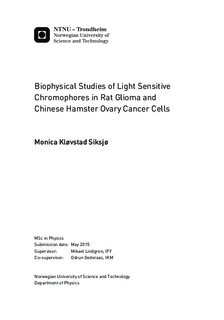| dc.description.abstract | The aim of this study was to investigate the biophysical properties of four light sensitive chromophores as a fluorescence dye for bioimaging applications, or photosensitizer in photodynamic therapy (PDT). Characterization of light induced cell death and DNA damage were performed using Chinese hamster ovary cancer cells (CHO-K1) after incubation of the anthracene compounds Ant-PIm and Ant-PHEA using the standard PDT technique; survical studies with MTT assay. Confocal microscopy was also performed including DRAQ5 and Lysotracker Red as refrence molecules for detection of the localization of the chromophore in cell compartments and nucleus in rat glioma (F98) and Chinese hamster ovary (CHO-K1) cell lines. Spectroscopic measurements such as absorption, excited state absorption, and singlet oxygen luminescence were performed to investigate important and necessary properties of the dyes as potential photosensitizers.
One of the chromophores (Ant-PIm) showed promising results for PDT with accelerated cell death upon illumination, but in addition a high dark toxicity. None of the tested chromophores caused any large DNA damage in CHO-K1 cells alone, or in combination with light. Only the chromophore DBB2-OAc showed the ability of having a long lived triplet state, and generation of singlet oxygen, making it a promising candidate for PDT. All four chromophores where proven to localize in the cell compartments in cytosol of both F98 and CHO-K1 cells, but not necessarily inside the cell nucleus.
This project was part of a collaborating study with ÉNS Lyon, France and NTNU, Norway. | |

